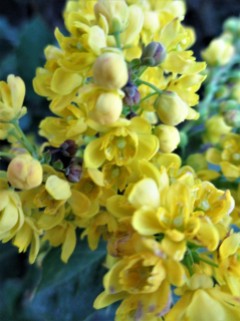Arrowleaf Balsamroot (Balsamorhiza sagittata)
- Other Names: None
- Family: Aster family (Asteraceae)
- Season: April-June
- Color: Yellow
- Habitat: Open hills and meadows; sagebrush
- Status: Native
Arrowleaf balsamroot is a large sunflower-like plant. Each of its stems are topped with a showy ray flower. Plants are usually 1-2 feet tall. The leaves are large, arrow-shaped, and hairy. The roots were eaten by Native Americans. It is found in Camel’s Back Park, Hulls Gulch, and Military Reserve.
Bare-stemmed Biscuitroot (Lomatium nudicaule)
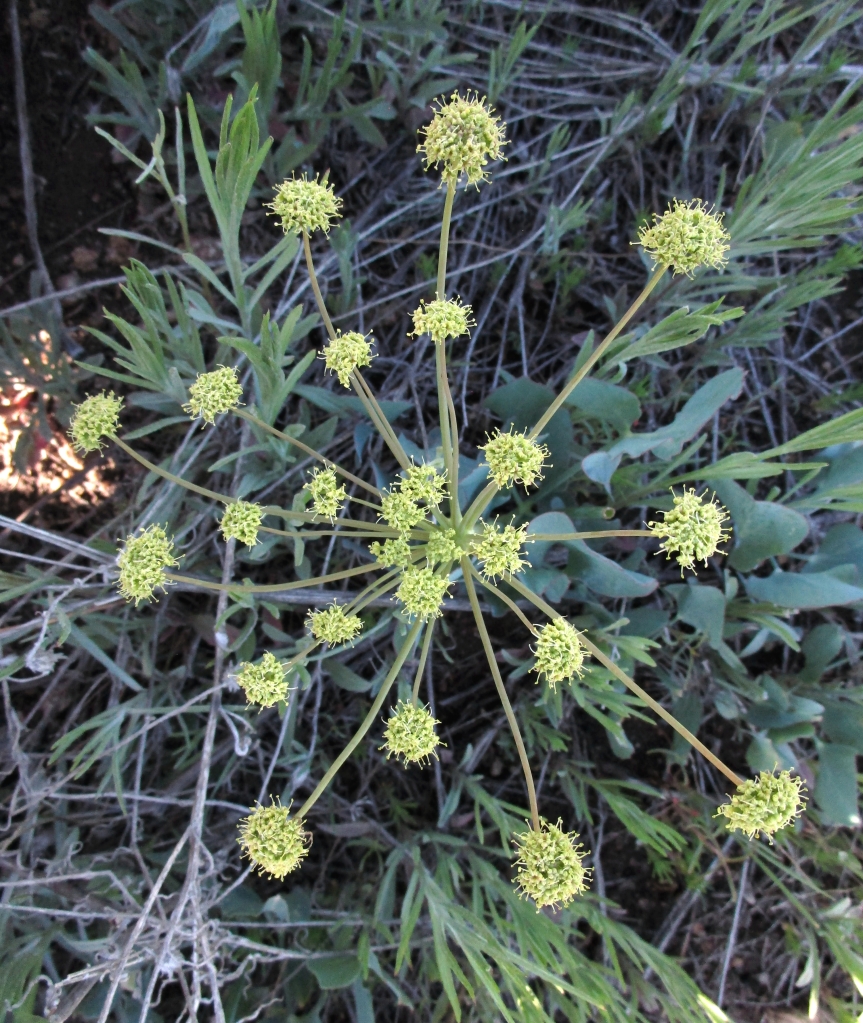

- Other Names: Pestle parsnip, Indian celery
- Family: Parsley family (Apiaceae)
- Season: April-May
- Color: Yellow
- Habitat: Gravelly slopes
- Status: Native
Bare-stemmed biscuitroot grows upwards of 30 inches tall. The flower clusters sit on thin, hollow stems. The oval leaves near the base of the plant may be smooth on the edges or have a toothed edge right at the tips. The plant was a source of food for Native Americans. It is found in Military Reserve.
Bitterbrush (Purshia tridentata)
- Other Names: Antelope bitterbrush, antelopebush
- Family: Rose family (Rosaceae)
- Season: April-May
- Color: Light yellow
- Habitat: Arid foothills; sagebrush
- Status: Native
Bitterbrush is a bush with tiny, five-petaled, radially-symmetrical flowers and lobed leaves. Each leaf has three to five lobes and is hairy on the underside. The bushes can be upwards of 8 feet tall. The flowers have a spicy smell. The plant is eaten by native deer species. It is found in Camel’s Back Park, Hulls Gulch, and Military Reserve.
Cinquefoil (Potentilla)

- Other Names: None
- Family: Rose family (Rosaceae)
- Season: June-August
- Color: Bright yellow
- Habitat: Open forests; meadows
- Status: Native
Cinquefoil is a shrubby plant with loose clusters of attractive, waxy flowers and reddish-brown stems. The flowers have five rounded petals. The leaves are hairy and pinnately-divided into five leaflets. Plants are 6-36 inches tall. There are several species in Idaho, with shrubby cinquefoil, sticky cinquefoil, and slender cinquefoil as the most common. It is found in Hulls Gulch and Military Reserve.
Columbia Puccoon (Lithospermum ruderale)

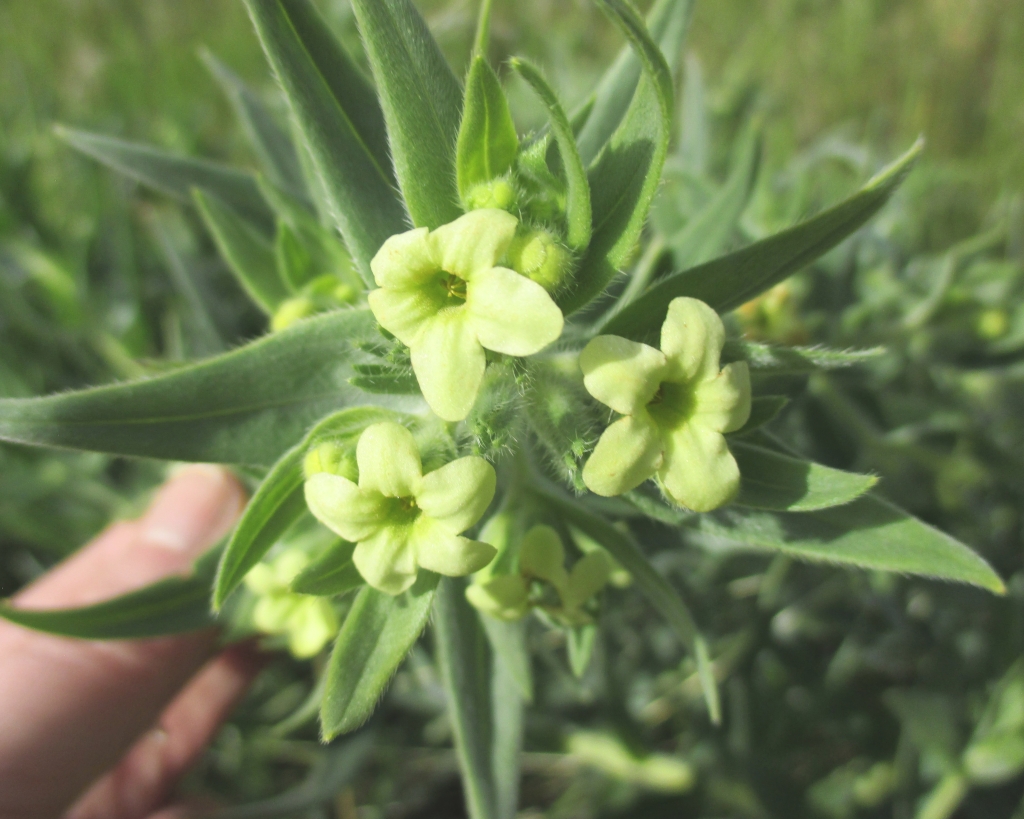
- Other Names: Stoneseed
- Family: Borage family (Boraginaceae)
- Season: April-June
- Color: Yellow
- Habitat: Open hills and meadows; sagebrush
- Status: Native
Columbia puccoon sports rounded clusters of small (1/3 inch) flowers with five petals. The plant grows to 30 inches tall. The leaves and stems are hairy, which gives the plant a grayish-greenish color. It is found in Hulls Gulch.
Common Eriophyllum (Eriophyllum lanatum)
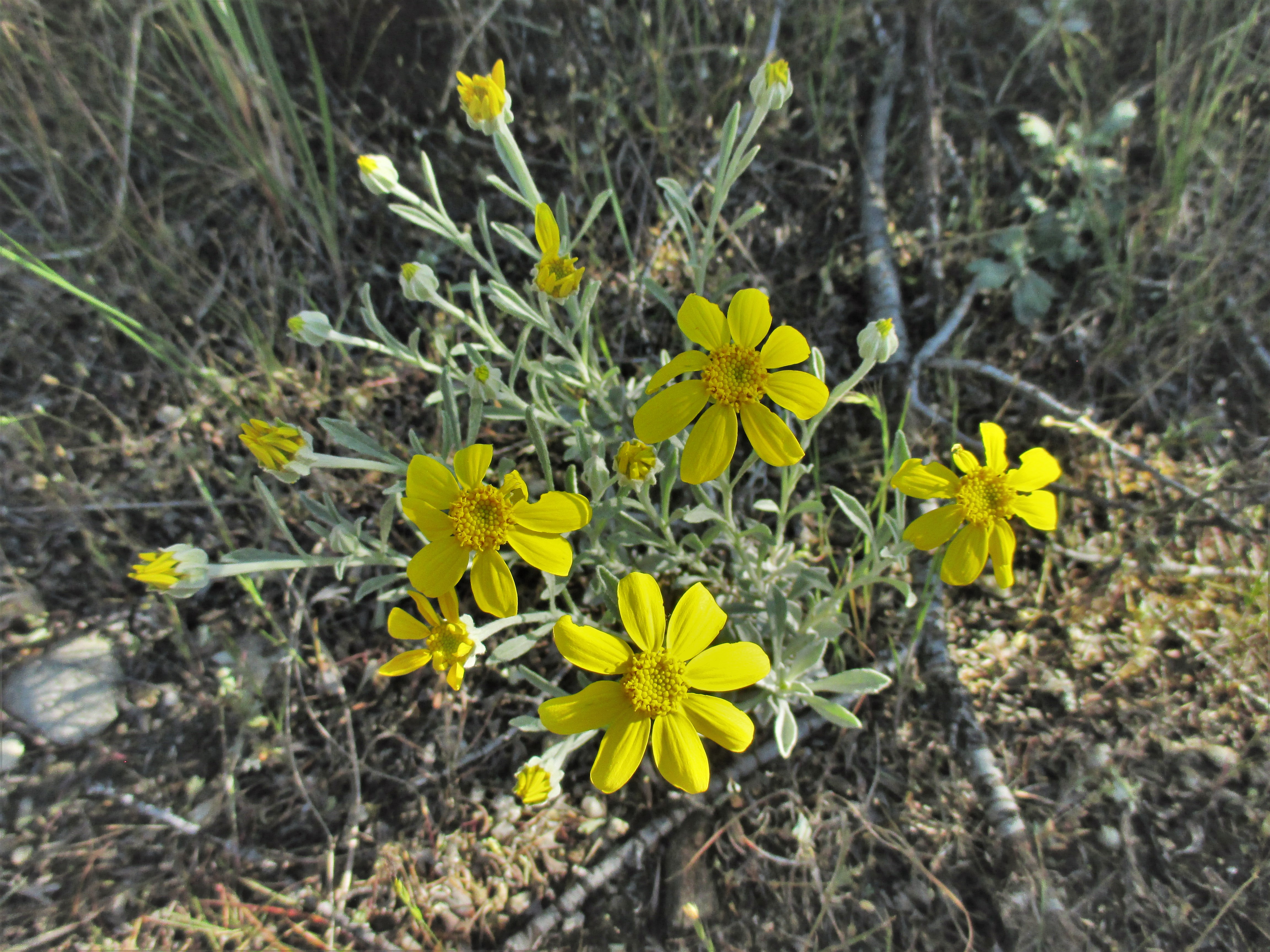
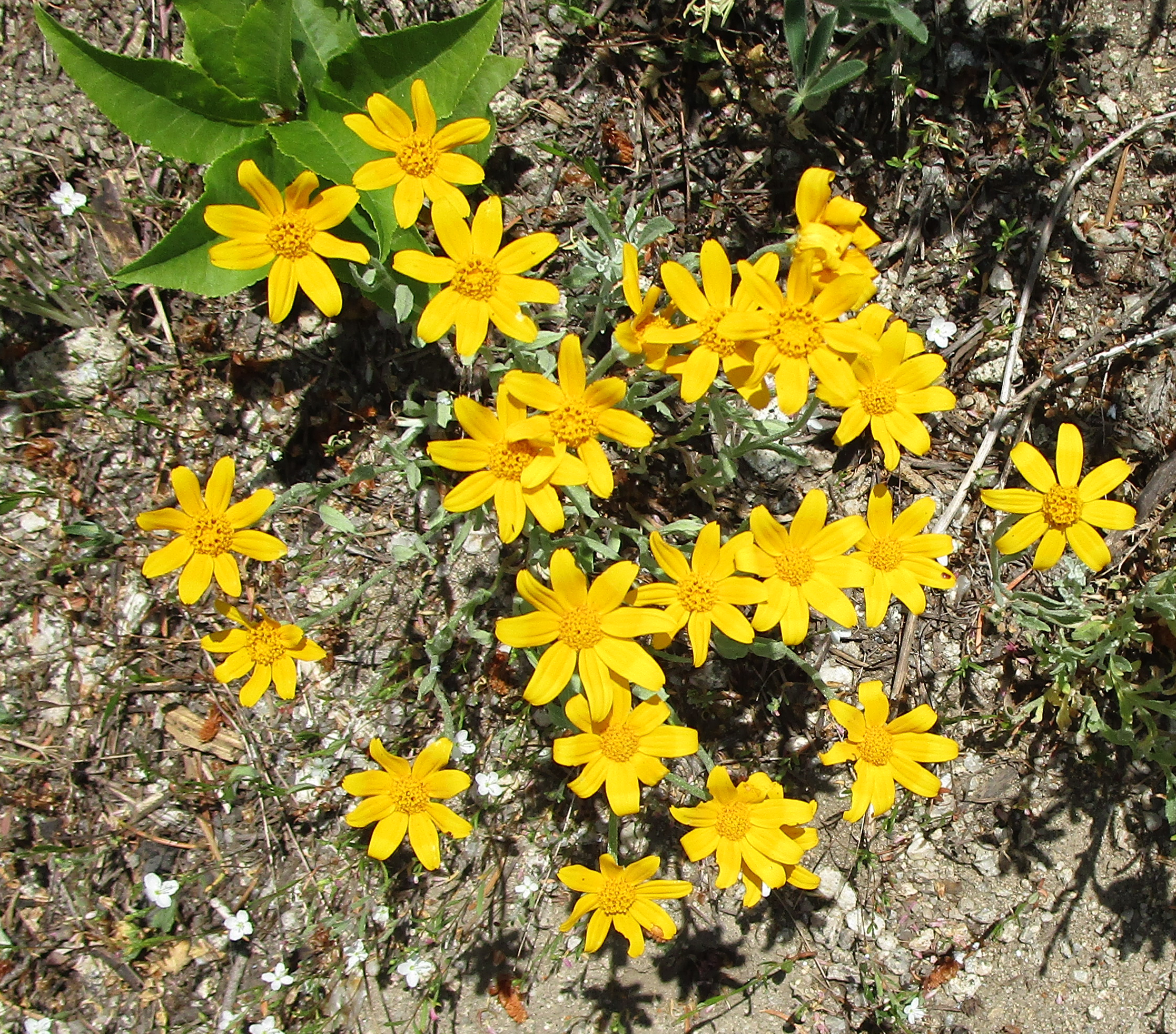
- Other Names: Wooly sunflower; Oregon Sunshine
- Family: Aster family (Asteraceae)
- Season: May-July
- Color: Yellow
- Habitat: Forest; sagebrush
- Status: Native
Common eriophyllum has many ray flowers with seven to eight petals on short stems. It has wooly, silvery leaves and grows from 4-24 inches in height. It is found in Hulls Gulch and Camel’s Back Park.
Common Fiddleneck (Amsinckia)

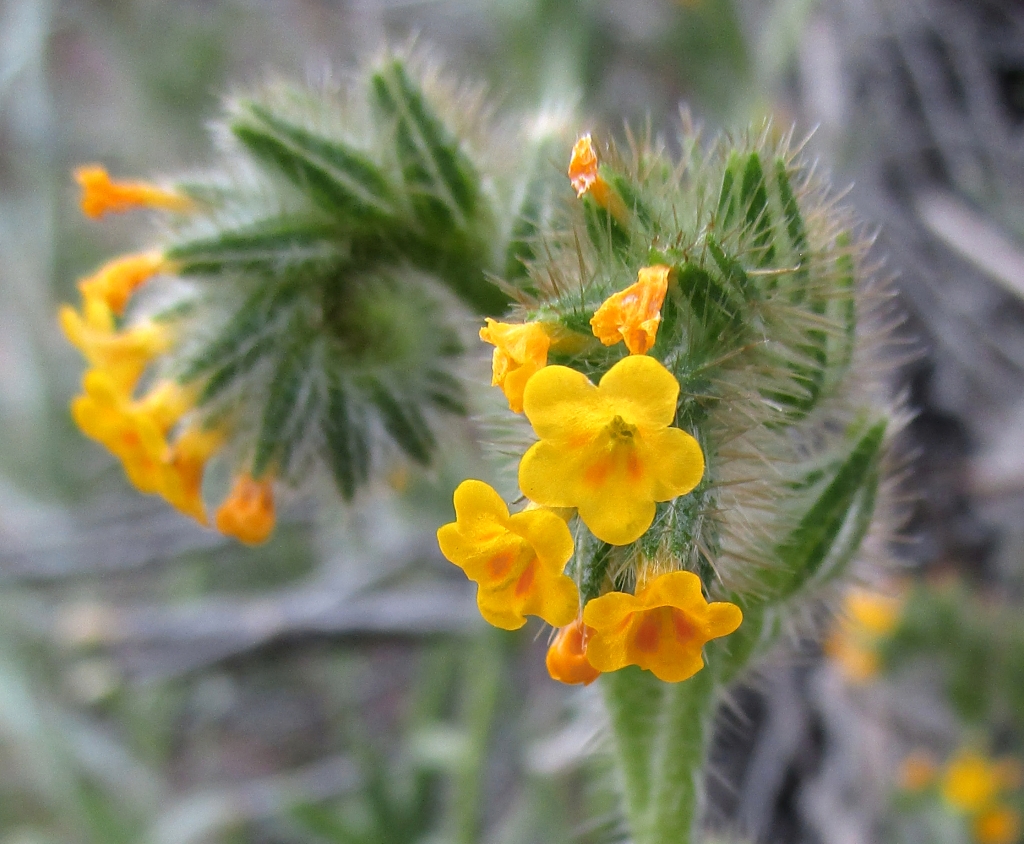
- Other Names: Rancher’s fireweed
- Family: Borage family (Boraginaceae)
- Season: April-June
- Color: Yellow
- Habitat: Dry, sandy areas
- Status: Native
Common fiddleneck has yellow-orange, trumpet-shaped flowers. The tiny flowers have five petals and unroll in a spiral like a fiddleneck fern. The stems and leaves are hairy. The plant is generally 1-3 feet in height. Several species, including rigid fiddleneck and tessellate fiddleneck, are found in Idaho. Common fiddleneck is found in Camel’s Back Park, Hulls Gulch, and Military Reserve.
Common Mullein (Verbascum thapsus)
Other Names: Grand mullein, wooly mullein
Family: Figwort family (Scrophulariaceae)
Season: June-August
Color: Yellow
Habitat: Clay soils; sagebrush
Status: Non-native
Common mullein features dense spikes of yellow flowers atop a single leafy stem. The flowers are almost radially symmetrical, with five petals (lobes) fused to a calyx tube. Leaves are hairy and are larger towards the base of the plant (up to 16 inches); they decrease in size higher up the plant. The plants are biennial; only second-year plants produce flowers. Flowering plants range from 2-7 feet tall. Common mullein is found in Camel’s Back Park, Hulls Gulch, and Military Reserve.
Common Sunflower (Helianthus annuus)

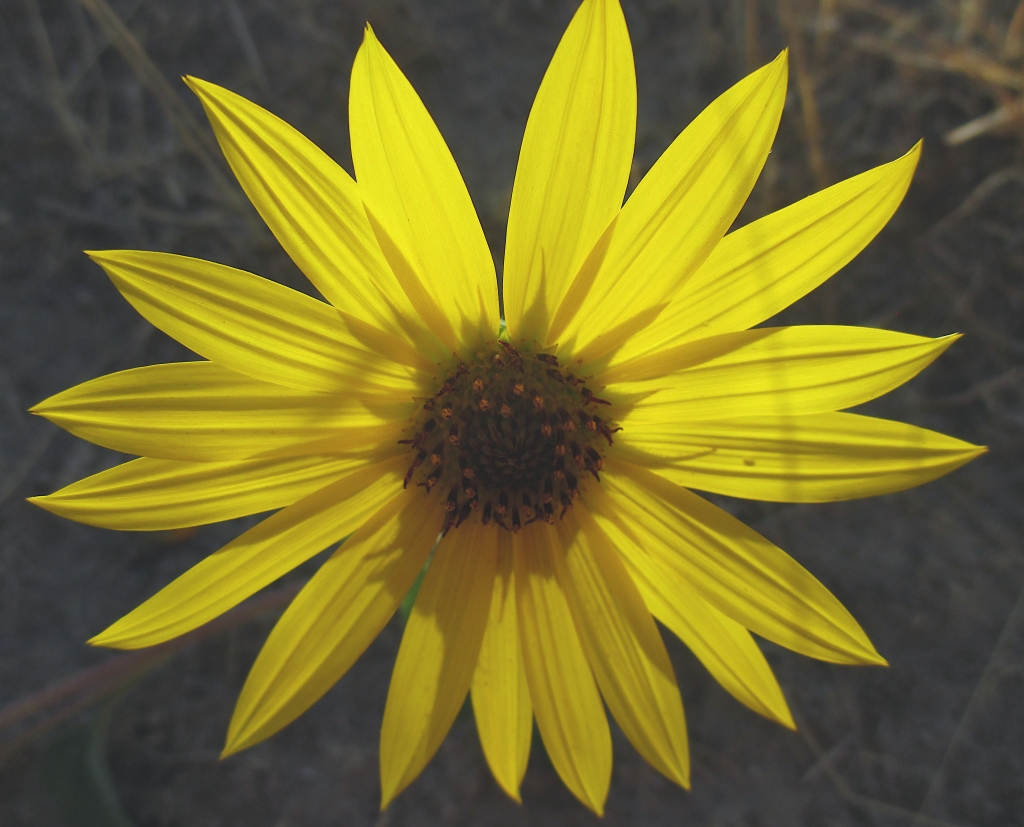
Other Names: None
Family: Aster family (Asteraceae)
Season: May-August
Color: Yellow
Habitat: Disturbed areas; open fields
Status: Native
Common sunflower is a tall plant that features bright yellow ray flowers and mostly heart-shaped leaves. Flowers sport narrow yellow petals and reddish-brown centers. Both the leaves and stems are covered in hairs; leaf edges are usually toothed. Plants range from 1-6 feet in height. Common sunflower is found in Camel’s Back Park and Military Reserve.
Curlycup Gumweed (Grindelia squarrosa)
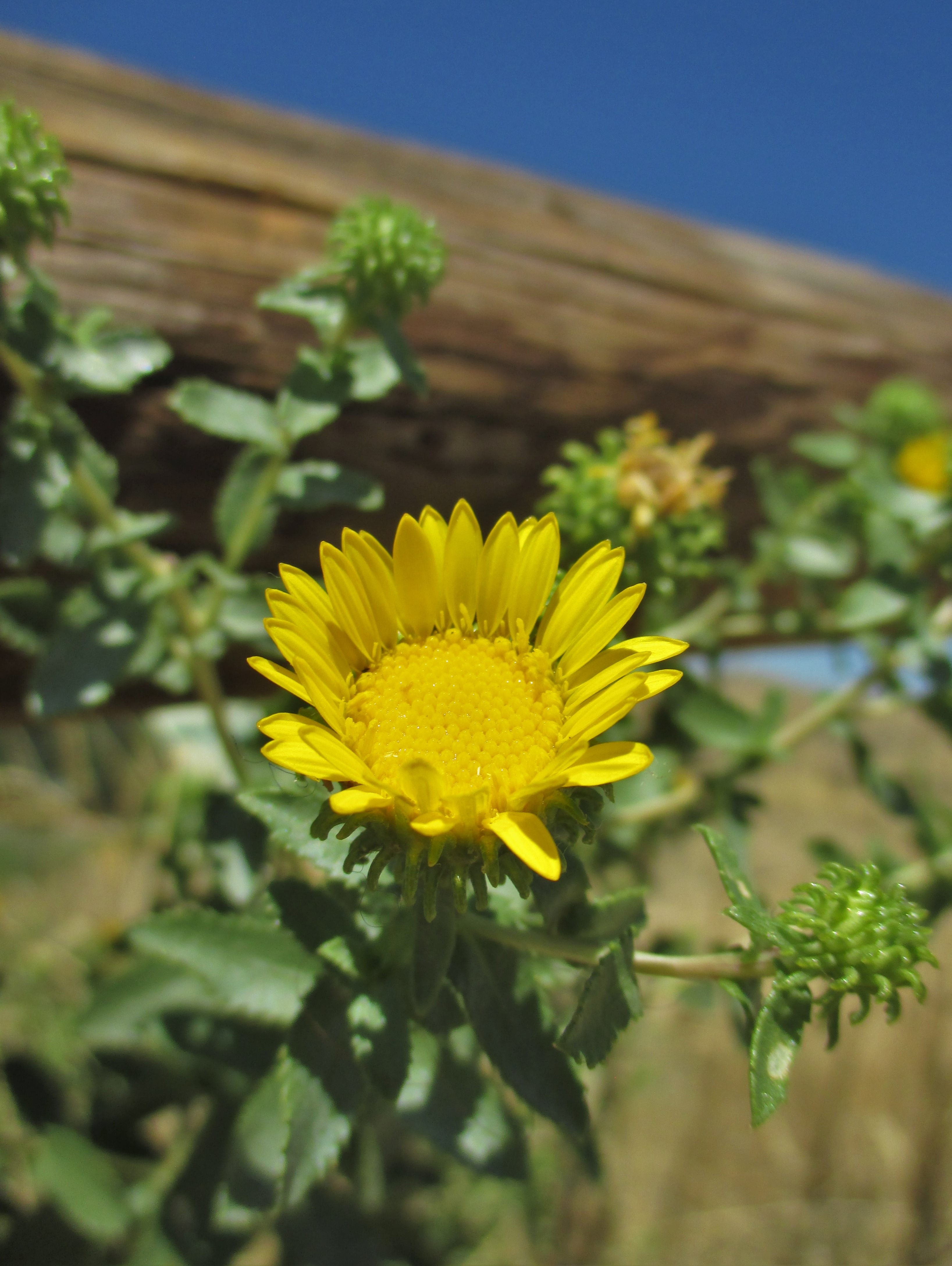
- Other Names: Stickyheads
- Family: Aster family (Asteraceae)
- Season: May-August
- Color: Yellow
- Habitat: Arid, open landscapes
- Status: Native
The flowerheads of curlycup gumweed are distinctively pineapple-shaped and covered with tiny down-facing hooks. Both flowers and leaves are sticky (resinous). Each flower has dozens of petals. The plant can be anywhere from 1-3 feet in height. It is found in Camel’s Back Park, Hulls Gulch, and Military Reserve.
Cushion Buckwheat (Eriogonum ovalifolium)


- Other Names: Oval-leaf buckwheat
- Family: Buckwheat family (Polygonaceae)
- Season: May-July
- Color: Yellow, cream, red, or purple
- Habitat: Sagebrush; ridges; open forest
- Status: Native
Cushion buckwheat is a highly variable species with up to eleven varieties. The plant boasts a low mat of wooly, ovate, grayish-green leaves from which tightly-packed clusters of minute flowers grow on leafless stems. The ball-like clusters of flowers are cream or yellow when young. As the plant matures, the flowers turn purple or red. Plants are 6-12 inches tall. Plants at lower elevations are taller than plants at higher elevations. Cushion buckwheat is found in Hulls Gulch and Military Reserve.
Desert Madwort (Alyssum desertorum)
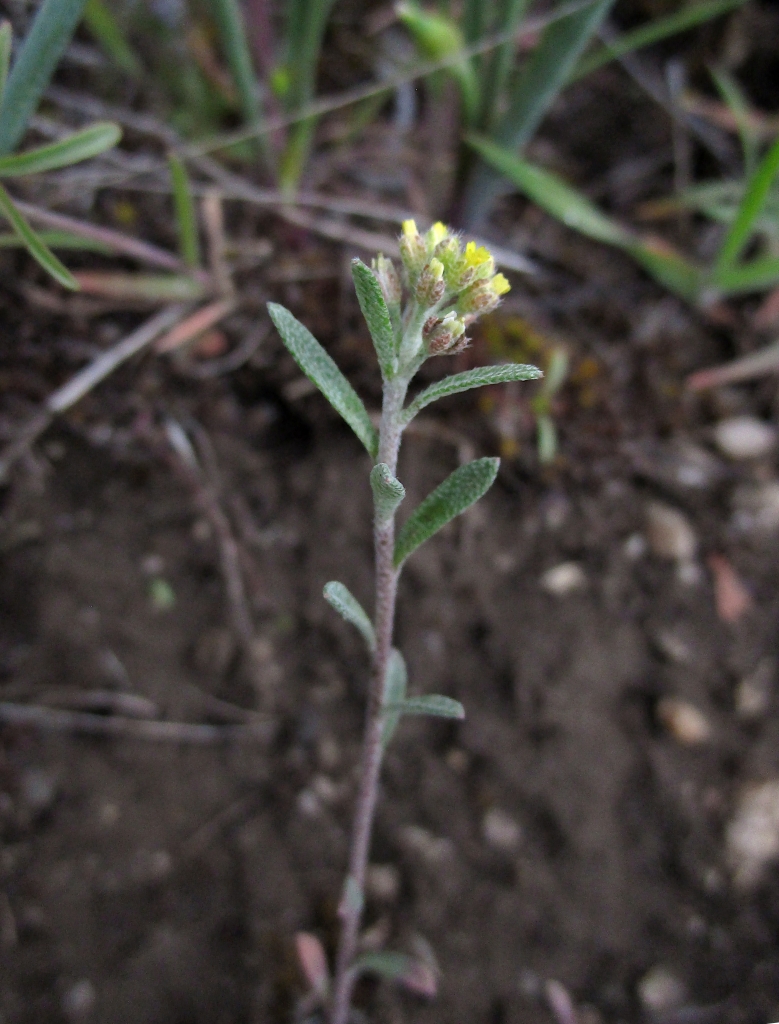
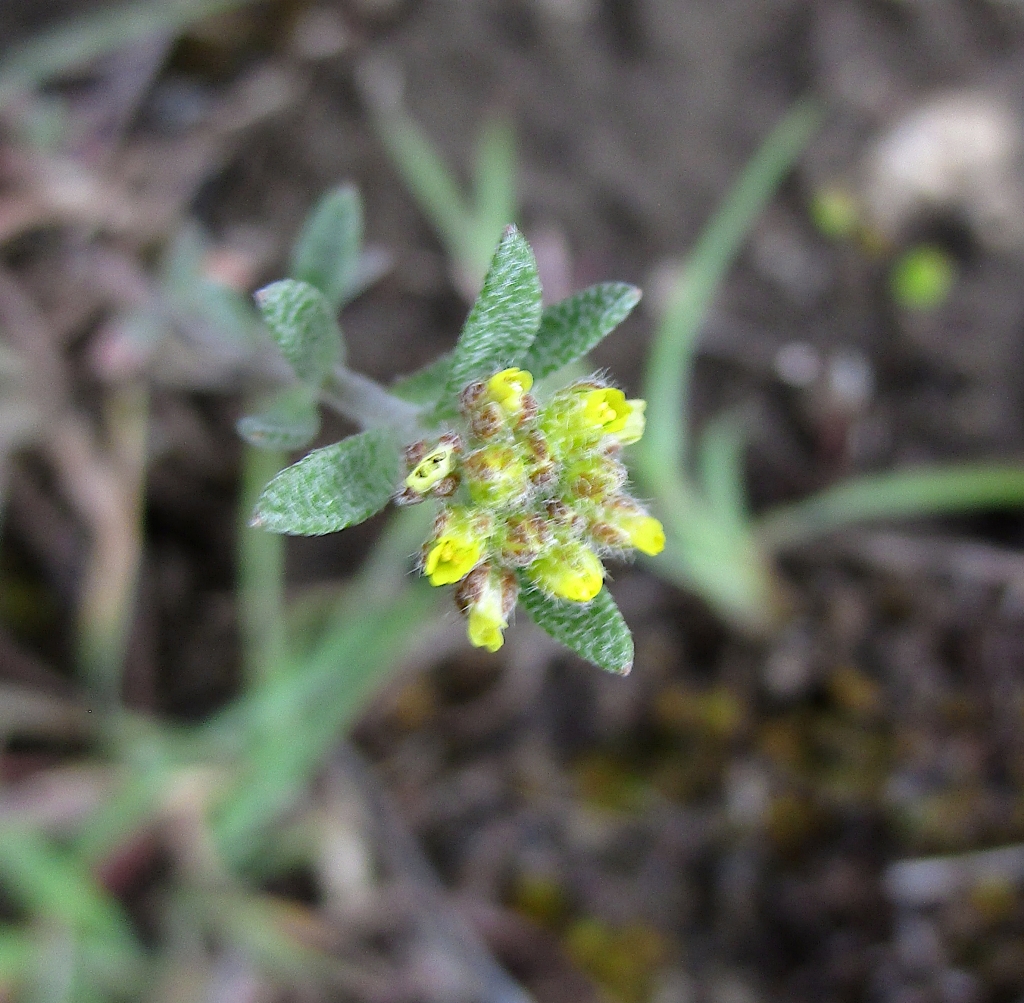
Other Names: None
Family: Mustard family (Brassicaceae)
Season: April-May
Color: Yellow
Habitat: Disturbed areas
Status: Non-native
Desert madwort is a diminutive flower that grows low to the ground. Plants have pale yellow flowers that bloom from the bottom of the stem upwards. Both the flowers and leaves are minute. The leaves are less than an inch long. The flowers are roughly 0.1 inch across. The tiny seedpods are saucer or paddle shaped. Plants are between 3-10 inches in height. Desert madwort is found in Camel’s Back Park, Lower Hulls Gulch, and Military Reserve.
Golden Currant (Ribes aureum)
- Other Names: None
- Family: Gooseberry family (Scrophulariaceae)
- Season: April-May
- Color: Yellow
- Habitat: Arid, rocky foothills
- Status: Native
Golden currant is a flowering shrub with star-shaped flowers. The flowers have a spicy, vanilla-like aroma. The edible berries range in color from orange to black when ripe (usually in July). The leaves are distinctly maple-shaped. The shrubs are generally 6-9 feet tall. It is found in Camel’s Back Park, Hulls Gulch, and Military Reserve.
Valley Violet (Viola vallicola)
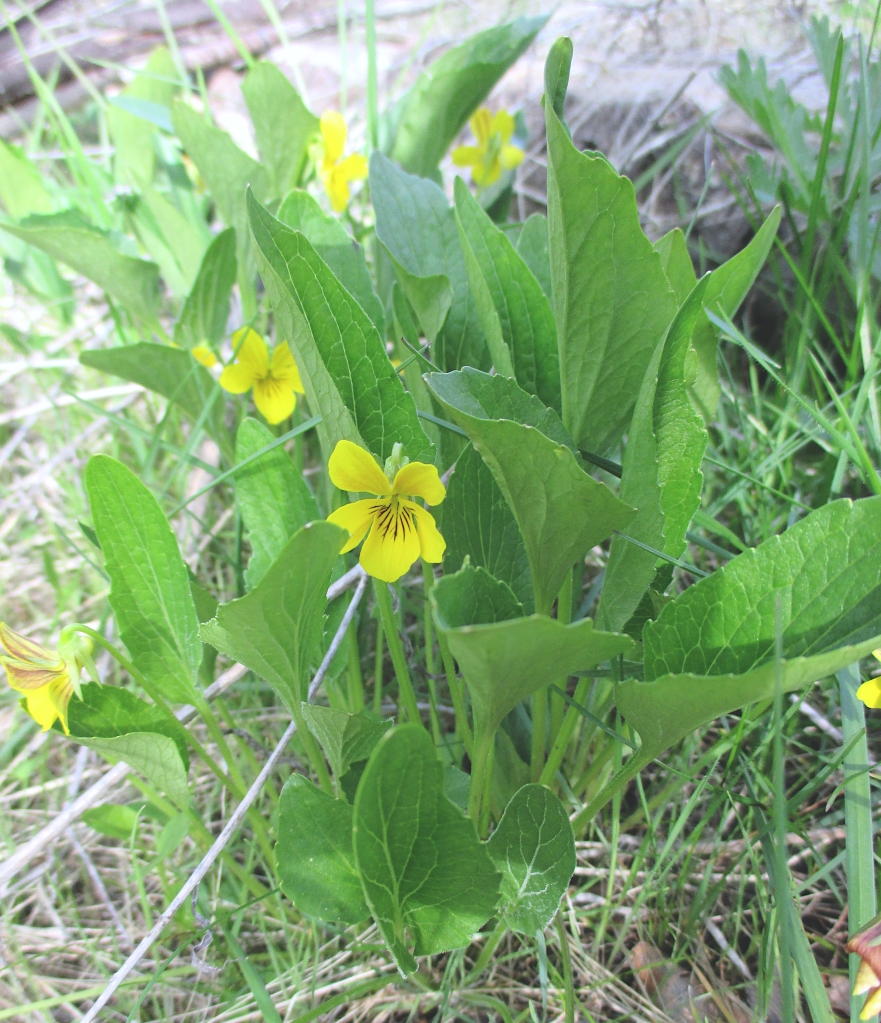

- Other Names: Nuttall’s Violet
- Family: Violet family (Violaceae)
- Season: April-June
- Color: Yellow
- Habitat: Dry slopes; foothills
- Status: Native
Valley violet has bilaterally-symmetrical flowers with five petals. The lower three petals have dark purple vertical lines. The leaves are spade-shaped and have ragged, faintly-toothed edges. It grows from 2-6 inches in height. It is found in Hulls Gulch.
Gray’s Biscuitroot (Lomatium grayi)

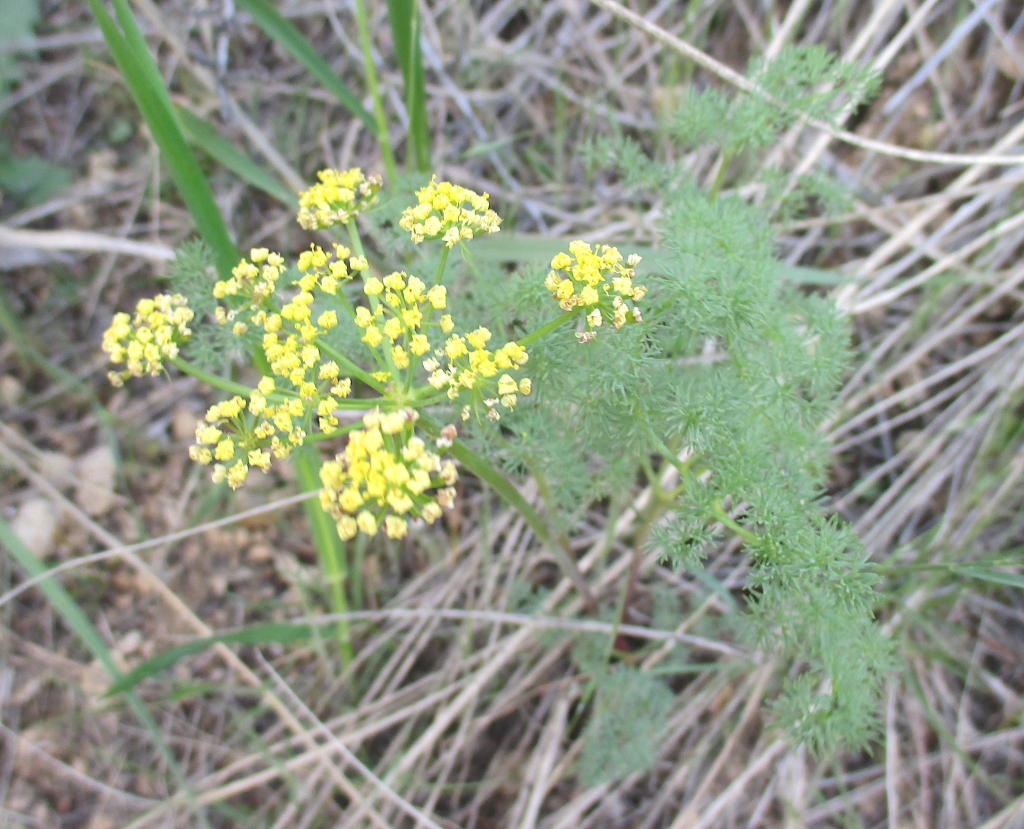
- Other Names: Desert parsley
- Family: Parsley family (Apiaceae)
- Season: April-May
- Color: Yellow
- Habitat: Rocky slopes; sagebrush
- Status: Native
Gray’s biscuitroot has flat clusters of tiny flowers that radiate out from a single point atop leafless stems. The flowers eventually fade to white. The leaves are feathery, fern-like, and exude a parsley-like odor when crushed. The plant grows to 2 feet in height. Fernleaf biscuitroot, a similar species, is also found in the area. Gray’s biscuitroot is found in Hulls Gulch.
Gray Hawksbeard (Crepis occidentalis)
- Other Names: Western hawksbeard
- Family: Aster family (Asteraceae)
- Season: May-June
- Color: Yellow
- Habitat: Open hills and meadows; sagebrush
- Status: Native
Gray hawksbeard is a grayish-greenish hairy plant with many ray flowers. It grows to 30 inches in height. The leaves grow at the base of the plant and are up to 12 inches long. The leaves are wooly, with distinctive, deeply-serrated edges. Multiple hawksbeard varieties grow in Idaho. It is found in Camel’s Back Park, Hulls Gulch, and Military Reserve.
Klamath Weed (Hypericum perforatum)
Other Names: Common St. John’s Wort
Family: St. John’s Wort family (Hypericaceae)
Season: June-September
Color: Yellow
Habitat: Pastures; near water
Status: Non-native
Klamath weed is a yellow flowering weed from Eurasia. The plants have star-shaped flowers of five petals atop erect stems; flowers have noticeable black dots. The leaves are oblong and have translucent dots when held to the light. Plants range from 1-3 feet in height. Klamath weed can be found in Camel’s Back Park, Hulls Gulch, and Military Reserve.
Jim Hill Mustard (Sisymbrium altissimum)


- Other Names: Tumblemustard, tall mustard
- Family: Cabbage family (Brassicaceae)
- Season: May-July
- Color: Yellow
- Habitat: Burned areas; disturbed soils
- Status: Non-native
Jim Hill mustard is an invasive plant from Eurasia. The plant is 2-5 feet tall and boasts tiny flowers on delicate, highly-branched stems. Each flower has four petals, four narrow sepals, and stamens that usually extend beyond the petals. The upper leaves are narrow, linear, and deeply dissected. Basal leaves are larger (up to 8 inches), dandelion-like, and pinnately compound. The fruit (silique) is 2-5 inches long. Western tansymustard, a similar species, also grows in Idaho. Jim Hill mustard is found in Camel’s Back Park, Hulls Gulch, and Military Reserve.
Longspur Lupine (Lupinus arbustus)
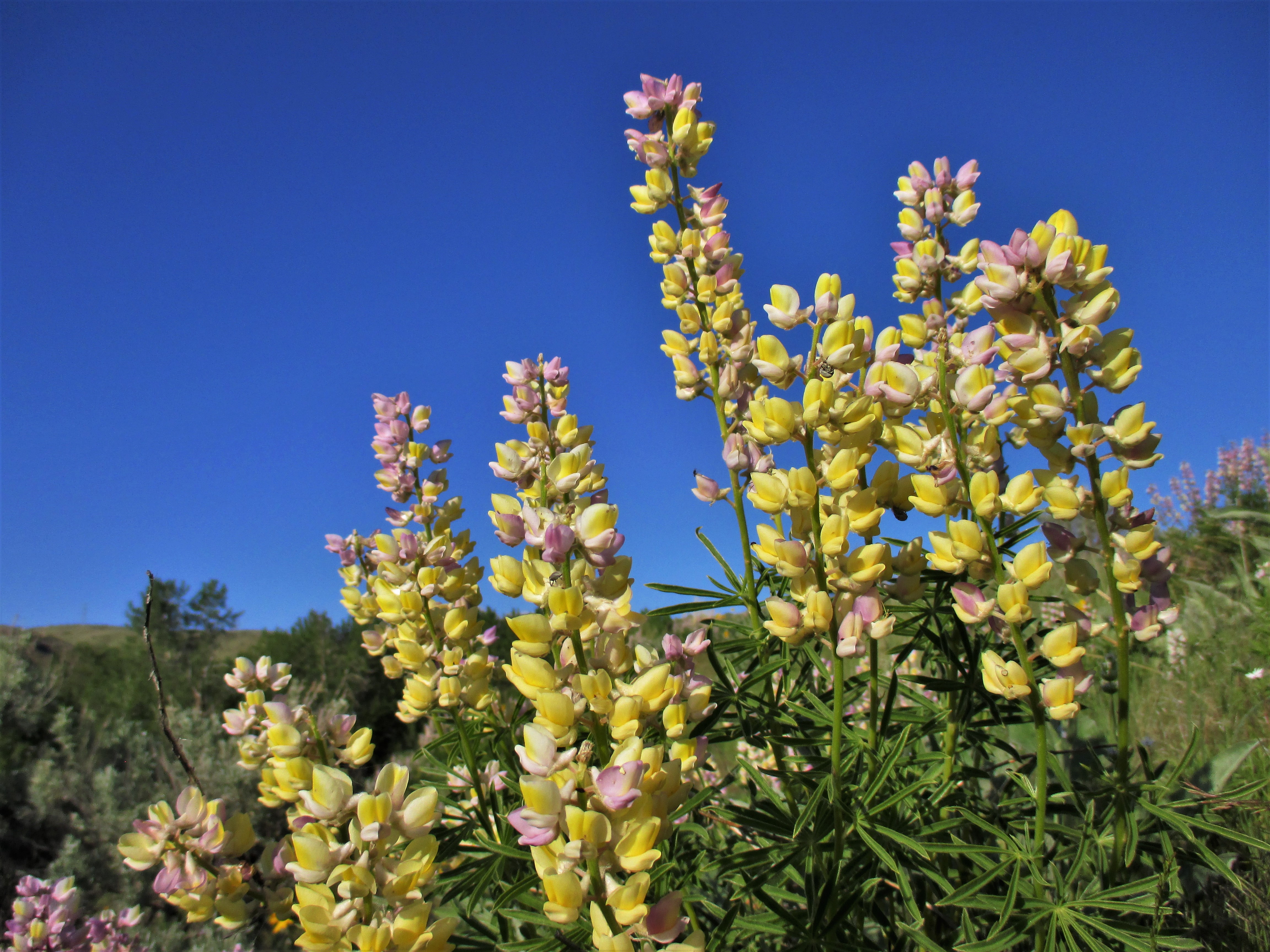
- Other Names: None
- Family: Pea family (Fabaceae)
- Season: May-June
- Color: Yellow and purple
- Habitat: Sagebrush
- Status: Native
Longspur lupine is one our most attractive wildflowers. It has elongated clusters of pea-like, bilaterally-symmetrical flowers in both yellow and purple. The flowers have a heady fragrance. It often grows in large numbers. The leaves are palmate, often with as many as a dozen leaflets. It can be upwards of 2 feet tall. It is found in Military Reserve.
Nineleaf Biscuitroot (Lomatium triternatum)
- Other Names: None
- Family: Parsley family (Apiaceae)
- Season: April-June
- Color: Yellow
- Habitat: Gravelly hills; sagebrush
- Status: Native
Nineleaf biscuitroot can be distinguished by its leaves, which contain three thin lobes that divide into three thin leaflets. Its round clusters of yellow flowers sit on a single stalk. Its edible taproots were eaten by Native Americans. Plants can reach 2 feet in height but are usually shorter (around 6-12 inches). It is found in Camel’s Back Park, Hulls Gulch, and Military Reserve.
Oregon Grape (Berberis aquifolium)
- Other Names: Mountain holly
- Family: Barberry family (Berberidaceae)
- Season: April-June
- Color: Yellow
- Habitat: Open forests; meadows
- Status: Native
Oregon grape is an evergreen shrub that grows to 3 feet tall. The shrub features shiny, holly-like leaves. Its dense clusters of small flowers are replaced by edible, blue-black fruit. Its roots have medicinal uses. It is found in Camel’s Back Park, Hulls Gulch, and Military Reserve.
Rabbitbrush (Ericameria / Chrysothamnus)
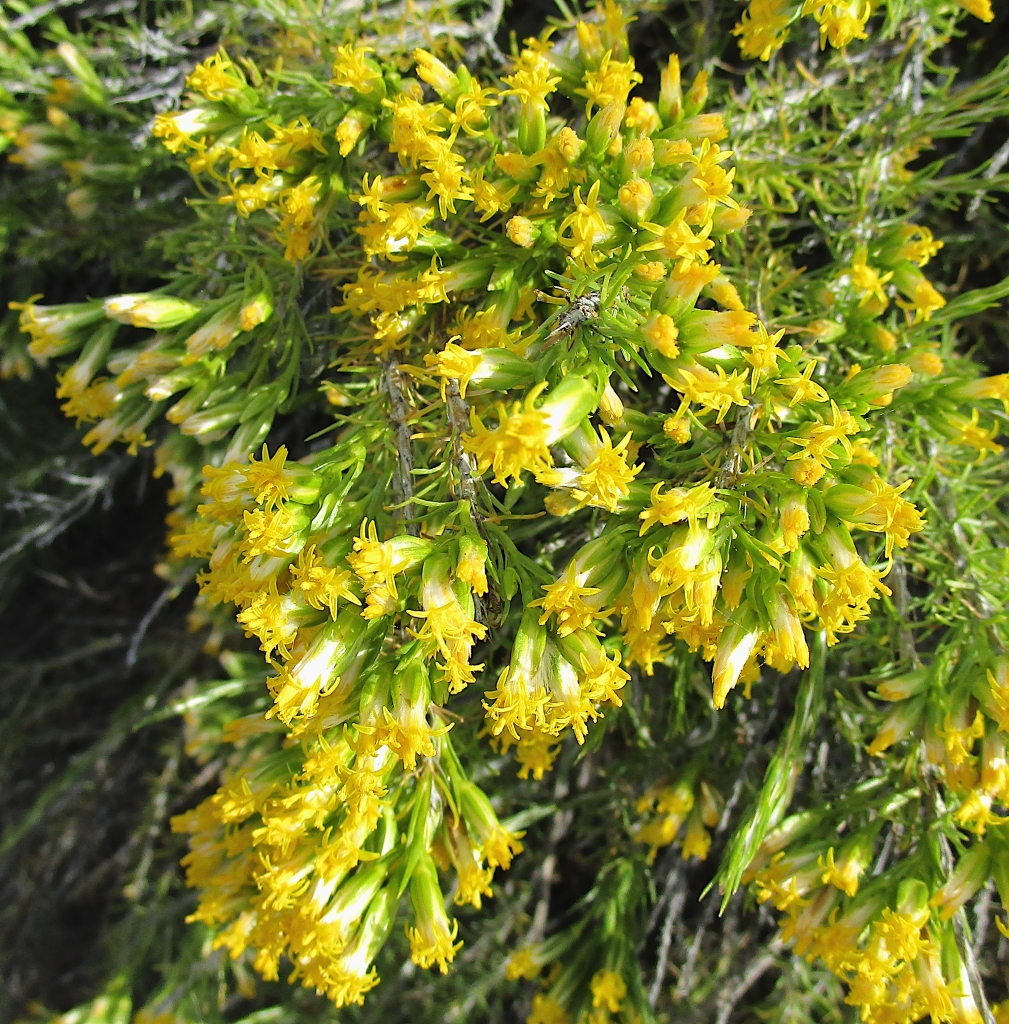

Other Names: None
Family: Aster family (Asteraceae)
Season: July-September
Color: Yellow
Habitat: Grasslands; sagebrush
Status: Native
Rabbitbrush is a common perennial shrub that blooms in late summer. The shrubs feature many yellow rayless flowers on flexible branches and thin grass-like leaves. There are two species in our area: rubber rabbitbrush (Ericameria nauseosa) and green rabbitbrush (Chrysothamnus viscidiflorus). Rubber rabbitbrush is the taller of the two; it grows to seven feet in height. Its stems and leaves are coated in gray hairs. It produces a sticky sap that can be turned into fine rubber. Green rabbitbrush is shorter (up to three feet in height) and is a favorite food of wild rabbits. Both plants were used by Native Americans to treat respiratory ailments. Rabbitbrush is found in Camel’s Back Park, Hulls Gulch, and Military Reserve.
Sagebrush Buttercup (Ranunculus glaberrimus)

- Other Names: None
- Family: Buttercup family (Ranunculus)
- Season: March-April
- Color: Yellow
- Habitat: Open forests; sagebrush
- Status: Native
Sagebrush buttercup is one of the earliest blooming wildflowers, making an appearance in March, sometimes blooming when snow it still on the ground. Plants range from 2-8 inches tall. The flowers have five shiny petals. The smooth, fleshy leaves are oval and have up to three lobes. It is found in Camel’s Back Park, Hulls Gulch, and Military Reserve.
Tapertip Hawksbeard (Crepis acuminata)


- Other Names: None
- Family: Aster family (Asteraceae)
- Season: May-June
- Color: Yellow
- Habitat: Open hills and meadows; sagebrush
- Status: Native
Tapertip hawksbeard has up to a hundred small flowers with five petals. Its leaves are distinctive with deeply-serrated edges. Its stems exude a milky juice when broken. The plant grows to 20 inches in height. It is found in Camel’s Back Park, Hulls Gulch, and Military Reserve.
Hermit Milkvetch (Astragalus eremiticus)

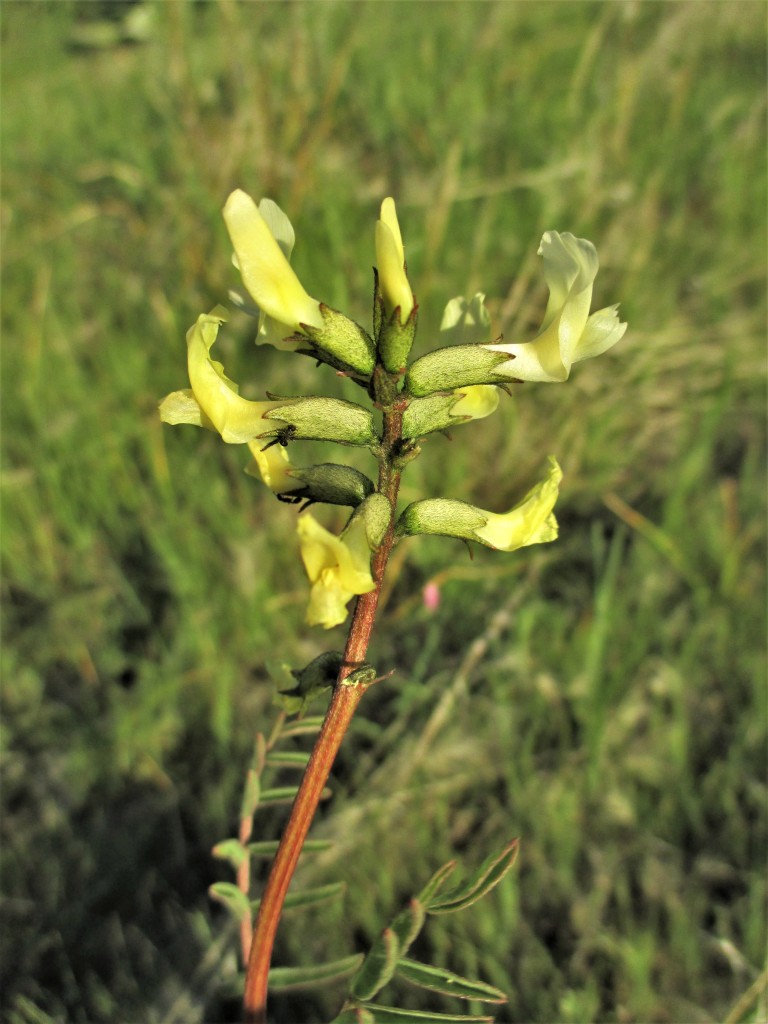
- Other Names: None
- Family: Pea family (Fabaceae)
- Season: May-July
- Color: Pale yellow
- Habitat: Open, gravelly hills
- Status: Native
Hermit milkvetch has elongated clusters of pea-like, bilaterally-symmetrical flowers atop reddish stems. The leaves are made up of small, ovate leaflets. The plant can be upwards of 2 feet tall. It is found in Military Reserve and Camel’s Back Park.
Yellow Salsify (Tragopogon dubius)


- Other Names: Goat’s beard
- Family: Aster family (Asteraceae)
- Season: May-July
- Color: Yellow
- Habitat: Open hills and fields; sagebrush
- Status: Non-native
Yellow salsify is a relative of the common dandelion. Each plant features a two-inch, ray flower on a hollow stem and a few narrow, grass-like leaves. Its seed head is a larger version of a dandelion seed head. It grows to 3 feet tall. It is found in Camel’s Back Park, Hulls Gulch, and Military Reserve.
Yellow Sweet Clover (Melilotus officinalis)

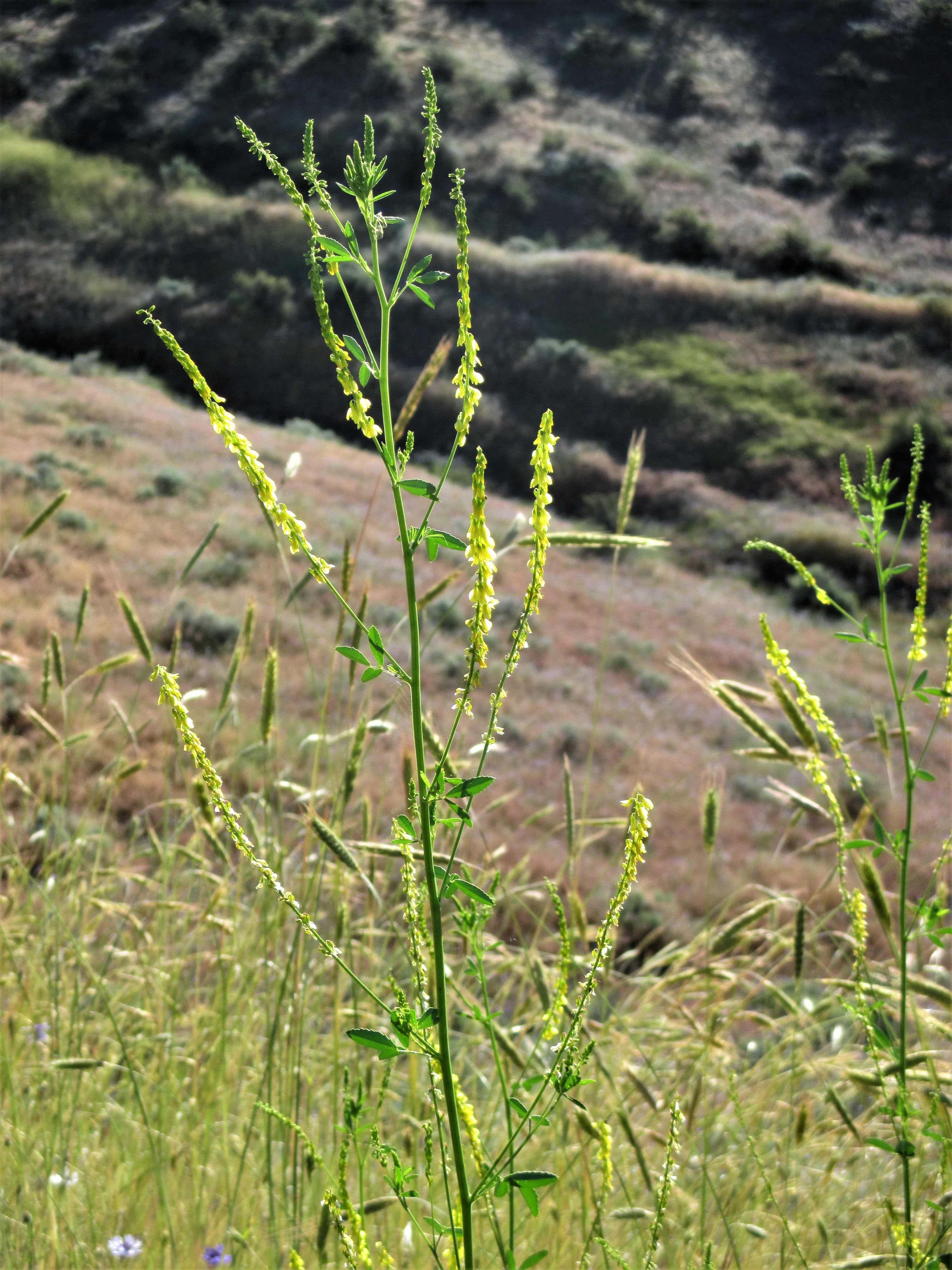
- Other Names: None
- Family: Aster family (Asteraceae)
- Season: May-June
- Color: Yellow; white
- Habitat: Open hills and meadows; sagebrush
- Status: Non-native
Sweet clover is an introduced plant from Europe. It features elongated clusters of small yellow or white flowers and leaves with three leaflets. It grows to 6 feet tall. It is found in Camel’s Back Park, Hulls Gulch, and Military Reserve.












